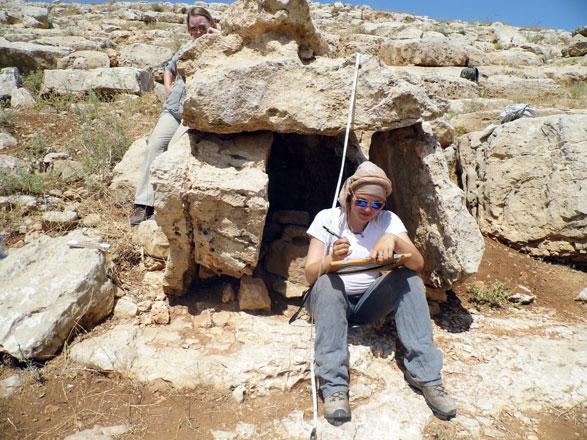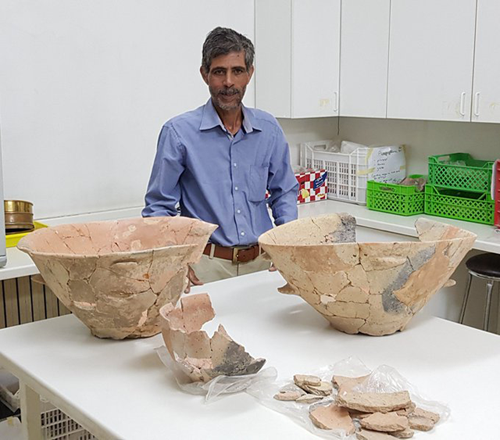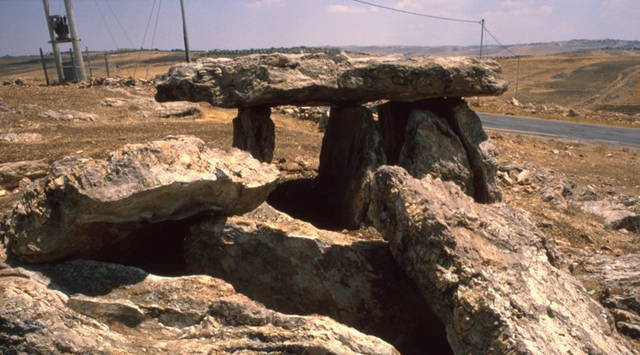You are here
Murayghat dolmen site near Madaba may have had ritualistic purpose — scholar
By Saeb Rawashdeh - Feb 23,2019 - Last updated at Feb 23,2019

One of the survey teams documents a dolmen at the Murayghat site near Madaba, in this undated photo (Photo courtesy of the Ritual Landscape of Murayghat project)
AMMAN — For some, Murayghat, a site located 3km southwest of Madaba, represents a “Jordanian Stonehenge”, with over 100 dolmens scattered throughout the countryside.
“It [the site] is unique, because of the combination of its central knoll with its most likely cultic buildings, its settlement component and the dolmens situated around these two elements,” said Susanne Kerner, director of the Ritual Landscape of Murayghat project. She underlined that such a mixture of dolmens and domestic structures is “unusual”, as “in most cases” there are only one or two of these elements at one archaeological site.
The project, which works to study the dolmens near Madaba, has three main objectives, according to the director. First and foremost is to learn as much as possible about the rather unique site; second is to protect dolmens that are under threat; and third is to address touristic concerns, she said.
According to Kerner, there are many dolmen fields in Jordan and they seem to have been used as burial sites.
“But the question is why do the people start burying their dead in very visible structures [such as dolmens] and in real cemeteries [like in Bab edh-Dhra], and what has changed in the social structure, and in the society that makes them do that,” she continued, adding: “I think it has a lot to do with settling down and occupying land. The whole social make-up of the society changed at the end of the earlier Chalcolithic [3800 BC] and I think the dolmens are one expression of this.”
“We have now 122 dolmens [complete and collapsed] recorded, but only 67 are documented in detail so far, most of these are in Area 4 [close to the central knoll],” Kerner elaborated.
Dolmens are usually closed off on one side with an entrance stone, have a floor or bottom slab, two large side stones and a capstone, according to Kerner who is an associate professor at the University of Copenhagen.
Some dolmens can also be surrounded by more stones, and only one dolmen at the site has been excavated so far. The material found during the excavation proved to be from the Early Bronze Age, the scholar stressed.
Regarding their role, dolmens seem to have been used for burials: “We have found only little direct evidence, but assume their use based on other excavations. This makes all the structures, made from standing stones on the central knoll, so interesting, because one assumes that they had a connection to the burial site.”
However, Kerner thinks that dolmens did not only play a burial role, but a role in rituals as well.
In regard to the tourist question, Kerner maintained that “the tourism around Madaba is concentrated on Mount Nebo, while few people see other things”.
“I would very much like to develop in the long run a ‘dolmen trail’, which takes those tourists who have a deeper interest along some other routes than the most common ones,” the scholar concluded.
Related Articles
AMMAN — Murayghat is a Prehistoric site located 3km southwest from Madaba known for the large number of dolmens scattered on its slopes.
AMMAN — Having survived thousands of years to tell stories about the Kingdom’s early societies, Jordan’s Late Bronze Age dolmens (upright st
AMMAN — There are two typical megalithic structures that can be found in Jordan-dolmens and menhirs. Dolmens are a single-chamber megal
















